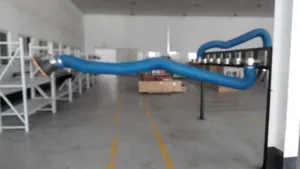Popular in your industry




































































Related Searches:


































































































































Top categories
About flexible exhaust arms
Introduction to Flexible Exhaust Arms
Flexible exhaust arms are essential components in the automotive exhaust system, designed to accommodate engine movement while maintaining a secure exhaust flow. These components are engineered for low-pressure drops, ensuring efficient gas expulsion, and are characterized by their flexibility and durability. With a small radius of curvature, they offer excellent maneuverability, making them suitable for a variety of automotive applications.
Types and Applications
The variety of flexible exhaust arms includes different designs to suit specific vehicle requirements. From standard flex pipes to more complex assemblies, each type serves the purpose of reducing stress on the exhaust system by absorbing vibrations and thermal expansion. Commonly used in both diesel and gasoline engines, these arms are integral to maintaining the integrity of the exhaust line and preventing leaks.
Features and Materials
Constructed to withstand harsh conditions, flexible exhaust arms are made from materials that offer resistance to high temperatures and corrosive chemicals. Stainless steel is often the material of choice, providing the necessary strength and flexibility. The design of these arms ensures that they can endure the rigors of daily operation without succumbing to the common issues of rust, cracks, and punctures.
Advantages of Upgrading
Replacing a worn-out exhaust arm can lead to noticeable improvements in vehicle performance. A new arm can reduce fuel overconsumption and eliminate unwanted noises or odors emanating from the exhaust system. Additionally, it can enhance the overall safety and comfort of the driving experience while contributing to better fuel economy and reduced emissions.
Signs of Wear and Replacement Indicators
Symptoms of a failing flexible exhaust arm include increased fuel consumption, metallic noises during acceleration, and the smell of gasoline inside the vehicle. It is generally recommended to inspect the exhaust arms regularly and consider replacement as part of routine maintenance to avoid these issues. While the lifespan of these components varies, it is common practice to check the straight exhaust pipe every 80,000 km and the tailpipe every 100,000 km.
Maintenance and Care
Proper maintenance of flexible exhaust arms is crucial for the longevity and efficiency of the exhaust system. Regular inspections can help identify early signs of wear, allowing for timely replacements without the need for changing additional connected parts. This proactive approach can prevent more significant issues within the automotive system and ensure optimal vehicle performance.


















































